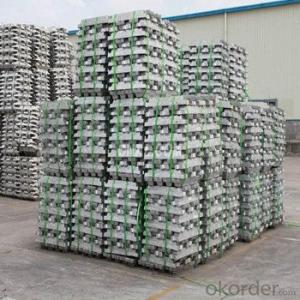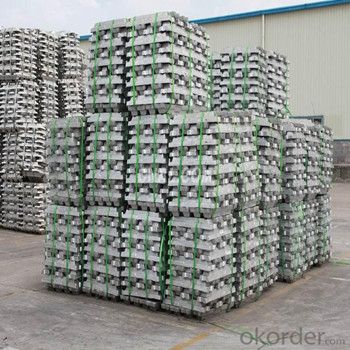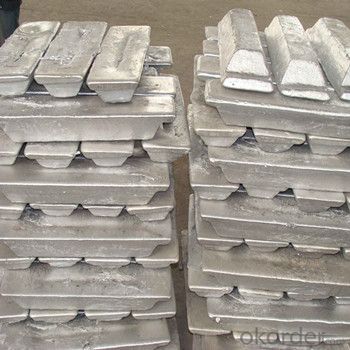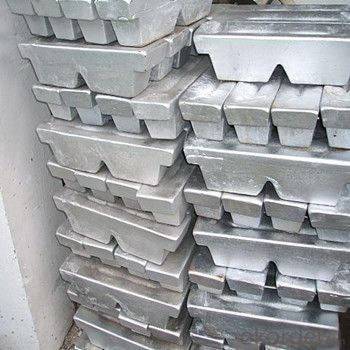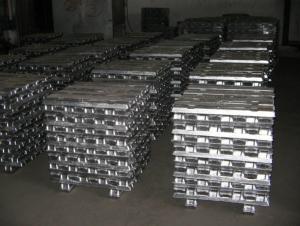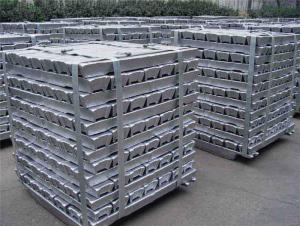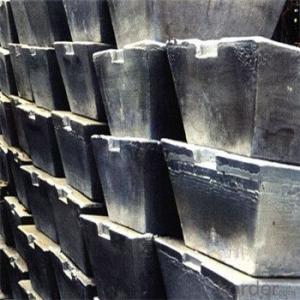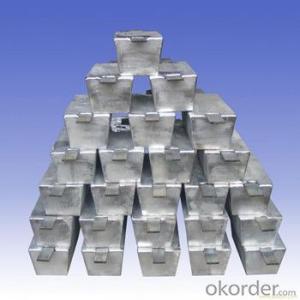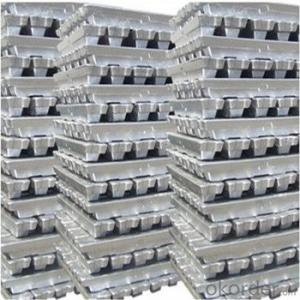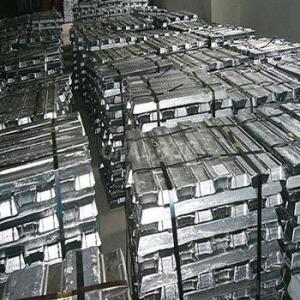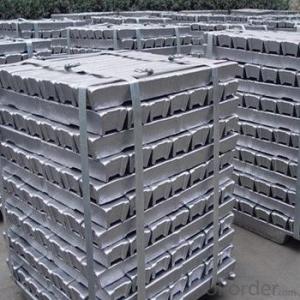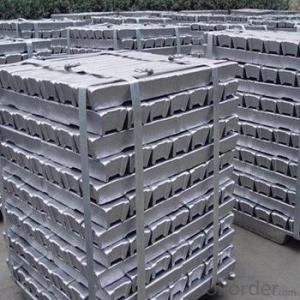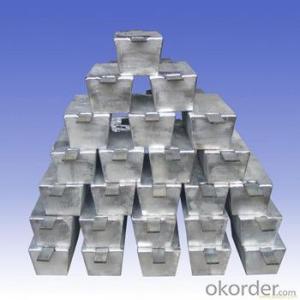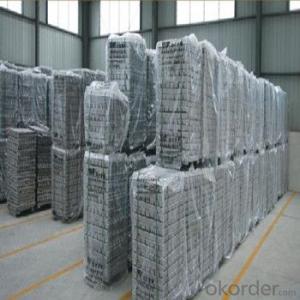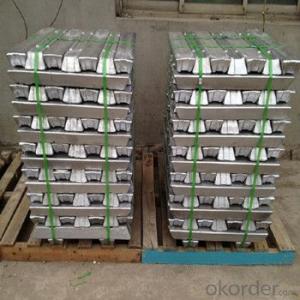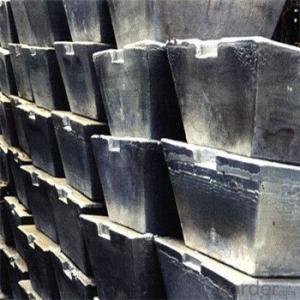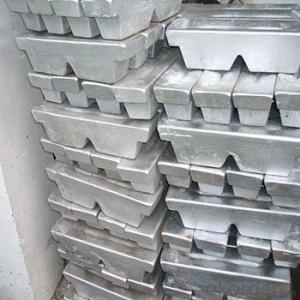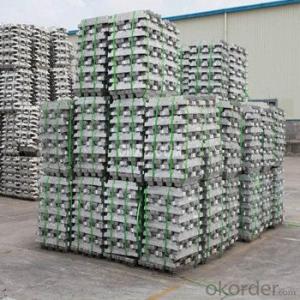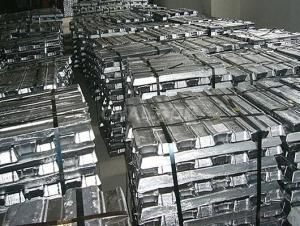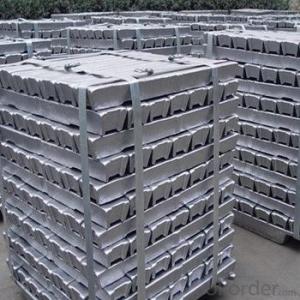Aluminum Pig/Ingot With Different Grade For Choice
- Loading Port:
- China main port
- Payment Terms:
- TT OR LC
- Min Order Qty:
- 1000 m.t.
- Supply Capability:
- 100000 m.t./month
OKorder Service Pledge
OKorder Financial Service
You Might Also Like
Pure Aluminum Pig/Ingot Used for Industry
1.Structure of Aluminum Pig/Ingot
A material that has been cast into a shape in order to be transported and processed easier than in an unprocessed form. An ingot is typically rectangular in shape, which allows it to be stacked. Ingots are most commonly associated with metals, with ingots of gold held in the vaults of banks and brokerages being popular images.
Aluminum Ingot is with the AL as the main chemical composition.Aluminum Ingot is used for industry,such as automobile,pinning and weaving,electron broadly and so on. Aluminum Ingot has the following advantages: easy control and operation, fast melting.
2.Main Features of the Aluminum Pig/Ingot
•High Purity
•Easy control and operation
•High strength
•Fast melting
•Competitive price
•Best Service
3.Aluminum Pig/Ingot Images
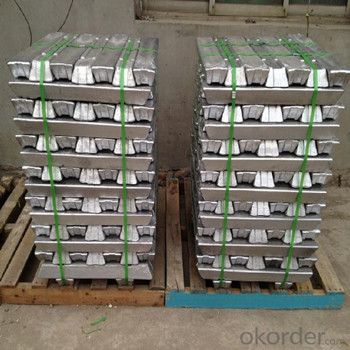
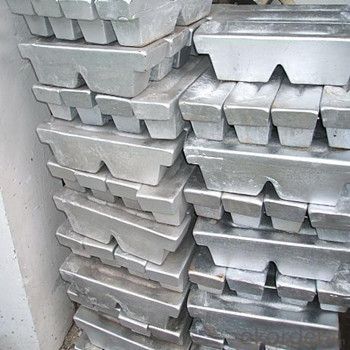
4.Aluminum Pig/Ingot Specification
Grade | Chemical Composition % | |||||||||
Al≥ | impurities ≤ | |||||||||
Si | Fe | Cu | Ga | Mg | Zn | Mn | others | Sum | ||
Al99.9 | 99.90 | 0.50 | 0.07 | 0.005 | 0.02 | 0.01 | 0.025 | - | 0.010 | 0.10 |
Al99.85 | 99.85 | 0.80 | 0.12 | 0.005 | 0.03 | 0.02 | 0.030 | - | 0.015 | 0.15 |
Al99.7 | 99.70 | 0.10 | 0.20 | 0.010 | 0.03 | 0.02 | 0.030 | - | 0.030 | 0.30 |
Al99.6 | 99.60 | 0.16 | 0.25 | 0.010 | 0.03 | 0.03 | 0.030 | - | 0.030 | 0.40 |
Al99.5 | 99.50 | 0.22 | 0.30 | 0.020 | 0.03 | 0.05 | 0.050 | - | 0.030 | 0.50 |
Al99.00 | 99.00 | 0.42 | 0.50 | 0.020 | 0.03 | 0.05 | 0.050 | - | 0.050 | 1.00 |
5.FAQ of Aluminum Pig/Ingot
We have organized several common questions for our clients,may help you sincerely:
①How about your company?
A big and famous and professional manufacturer & supplier of Aluminum Pig/Ingot, is one of the one of the large-scale professional investment Aluminum Pig/Ingot production bases in China.It have focuses on producing the Aluminum Pig/Ingot production for many years and gotten rich experience.Annually lagrge amount of Aluminum Pig/Ingot production are exported to markets in Europe,America and Japan. The quality and service have also gotten OEM service is available according to customer’s requirements.
②How to guarantee the quality of the products?
We have established the international advanced quality management system,every link from raw material to final product we have strict quality test;We resolutely put an end to unqualified products flowing into the market. At the same time, we will provide necessary follow-up service assurance.
③How long can we receive the product after purchase?
In the purchase of product within three working days, We will arrange the factory delivery as soon as possible. The pecific time of receiving is related to the state and position of customers.Commonly 7 to 10 working days can be served.
- Q: How much is each ton of aluminium ingot and stainless steel ingot?
- The density of gold is relatively large, but it still feels a little bit in the hands;
- Q: Now refining aluminum ingot profits? What are the main factories?
- The main fuel of the pot for coke, coal and coal, the effect is not good, the process is very simple, is to put the cans back into the pot melting aluminum water, with a spoon to scoop out the mold to cast into ingots, the need to pay attention to is because cans belongs to the thin material industry often said, it is easy to burn, the best the method is the first of the aluminum water in the pot, and then put the cans or pressed into blocks and then cast.
- Q: How do aluminum ingots contribute to the overall aluminum industry?
- The overall aluminum industry heavily relies on aluminum ingots, which serve as the primary raw material for producing various aluminum products. To create ingots, aluminum ore is smelted and the resulting molten metal is poured into molds to solidify. Aluminum ingots offer great versatility as they can be further processed and shaped into different forms like sheets, plates, rods, tubes, and extrusions. These forms find applications in various industries, including automotive, aerospace, construction, packaging, electrical, and consumer goods sectors. Additionally, aluminum ingots provide several advantages that contribute to the growth and sustainability of the aluminum industry. Aluminum is lightweight, corrosion-resistant, and possesses excellent conductivity, making it an ideal choice for numerous applications. Its low density enables energy efficiency in transportation, reducing fuel consumption and emissions in the automotive and aviation sectors. Moreover, aluminum's corrosion resistance ensures longer-lasting products, reducing maintenance and replacement costs. The availability and affordability of aluminum ingots also play a significant role in the aluminum industry. Aluminum is the third most abundant element on Earth's crust and can be easily extracted from bauxite ore. This accessibility, combined with efficient production processes, makes aluminum ingots readily available for manufacturers at competitive prices, stimulating demand and market growth. Furthermore, the recycling potential of aluminum ingots contributes to the industry's sustainability. Aluminum is infinitely recyclable, meaning it can be melted and reused without any loss in quality. Recycling aluminum requires only a fraction of the energy compared to primary production, resulting in significant energy savings and reduced environmental impact. The use of recycled aluminum ingots helps conserve natural resources, reduce waste, and lower carbon emissions. In conclusion, aluminum ingots are indispensable to the overall aluminum industry as they provide the raw material for manufacturing a wide range of aluminum products. Their versatility, lightweight nature, corrosion resistance, and recyclability make them highly valuable for multiple industries. The availability and affordability of aluminum ingots further contribute to the industry's growth and sustainability, while their recycling potential helps conserve resources and reduce environmental impact.
- Q: How is the purity of aluminum ingots determined?
- The purity of aluminum ingots is determined through various analytical techniques and testing methods. One common method used is spectroscopy, specifically inductively coupled plasma optical emission spectroscopy (ICP-OES) or inductively coupled plasma mass spectrometry (ICP-MS). These techniques are capable of analyzing the elemental composition of the aluminum ingot, including the presence of impurities such as iron, silicon, copper, zinc, and others. Another technique employed is atomic absorption spectroscopy (AAS), which focuses on measuring the concentration of specific elements in the aluminum ingot. This method allows for the detection of trace impurities, as it is highly sensitive and selective for individual elements. Chemical analysis is also utilized to determine the purity of aluminum ingots. Acid digestion methods, such as dissolution in nitric acid or hydrochloric acid, are commonly used to dissolve the ingot and create a solution that can be analyzed for impurities. The resulting solution is then subjected to various tests, including titration, colorimetry, or gravimetric analysis, to quantify the impurities present. In addition to these techniques, physical testing methods can be employed to evaluate the purity of aluminum ingots. These methods involve measuring the physical properties of the ingot, such as density, melting point, or electrical conductivity. Deviations from the expected values can indicate the presence of impurities. Overall, determining the purity of aluminum ingots involves a combination of spectroscopic, chemical, and physical analysis techniques, allowing for a comprehensive assessment of the elemental composition and impurity levels in the ingot sample.
- Q: How are aluminum ingots used in the production of sports equipment?
- The lightweight, durable, and corrosion-resistant properties of aluminum ingots make them widely used in the production of sports equipment. Various sports gear, including baseball bats, tennis rackets, golf clubs, and bicycles, heavily rely on these ingots as the primary material. To manufacture the sports equipment, the aluminum ingots are first melted and then poured into molds to achieve the desired shape and size. Once the molten aluminum cools and solidifies, a strong and solid structure is formed. The lightweight nature of aluminum ingots is one of their major advantages. This characteristic makes the sports equipment easier to handle and maneuver, reducing the effort exerted by athletes during play. For instance, aluminum baseball bats are recognized for their lightweight design, allowing players to swing the bat with greater speed and precision. Furthermore, aluminum ingots offer excellent durability, ensuring that the sports equipment has a longer lifespan. They are resistant to wear and tear, making them suitable for intense sports activities. For example, aluminum tennis rackets can withstand the impact of tennis balls and maintain their shape and performance over an extended period. Moreover, aluminum ingots possess exceptional corrosion resistance, which is particularly advantageous for sports equipment exposed to various environmental conditions, such as bicycles. Aluminum bicycle frames made from ingots are resistant to rust and corrosion, resulting in an extended lifespan and improved performance. In conclusion, aluminum ingots play a vital role in the production of high-quality and high-performance sports equipment. Their lightweight, durable, and corrosion-resistant properties contribute to the creation of sports gear that enables athletes to excel in their respective sports.
- Q: How to cast aluminum ingots
- Scrap recycling, scrap for the aluminum content is not the same, so I want to return to the pure aluminum, almost impossible, even if feasible, cost is very high, and we generally refers to aluminum ingots, aluminum ingots for remelting, aluminum content of 99.7%, it is a pure substance. Therefore, after the general scrap steel after quenching and tempering, for direct processing Aluminum Alloy or cast aluminum rod.
- Q: Process description of aluminium ingot
- Casting alloy ingots must be clarified for more than 30min. After cleaning, the slag can be cast. When casting, the furnace of the mixing furnace is aligned with the second and third moulds of the casting machine, so as to ensure the change of the liquid flow and a certain flexibility when changing the die. Furnace eyes and casting machine with a groove connection groove shorter is better, it can reduce the oxidation of aluminum, avoid vortex and splash, casting machine above disable 48h, restart, will die at 4h. The liquid aluminum mold with a shovel into the groove, the surface of liquid aluminum oxide film is removed, called slag. Flow with the first mock exam, will move down a chute mould casting machine is a continuous progress. The mould is moved in sequence, and the aluminum liquid is cooled gradually. When the casting machine reaches the middle of the casting machine, the aluminum liquid has been solidified into aluminium ingot, and the smelting number is printed by the printer. When the aluminum ingot reaches the top of the casting set, it has been completely solidified into aluminum ingot. At this time, the mold is turned over and the ingot is released and dropped on the automatic ingot car. The stacker is automatically stacked and bundled to become the finished aluminum ingot. The casting machine is cooled by spraying water, but must be started in the casting machine, turn full circle before water can be supplied. The aluminum liquid consumes about 8-10t water per ton, and a blower is needed to cool the surface in summer. The casting ingot belongs to the flat mold casting, the solidification direction of the aluminum liquid is from bottom to top, and the upper part is solidified at last, leaving a groove depression. The solidification time and the condition of each part of the aluminium ingot are different, so their chemical composition will be different, but it is in conformity with the standard as a whole.
- Q: What kind of material is die casting aluminium ingot?
- Product (Unwrought). Products obtained by smelting (or refining) and casting. For example, rolled ingots, extruded ingots, wrought ingots, and remelting ingots
- Q: What is the difference between a aluminium ingot with and without a ticket?
- Beijing's purchase price is the price of aluminum, aluminum ingot + processing fees, billing is generally not a ton of processing fee will be about 400 yuan less, your price is overall, the overall profits can be, I think do not have to manage open ballot problem of aluminum ingots.
- Q: What are the challenges in sourcing sustainable aluminum ingots?
- One of the challenges in sourcing sustainable aluminum ingots is ensuring a transparent and traceable supply chain. It can be difficult to verify the sustainability claims made by suppliers and ensure that they are adhering to environmentally-friendly practices throughout the production process. Additionally, there may be limited availability of sustainable aluminum ingots, as the demand for such products may exceed the current supply. Finally, the cost of sourcing sustainable aluminum ingots can be higher compared to conventional options, which can pose a financial challenge for businesses.
Send your message to us
Aluminum Pig/Ingot With Different Grade For Choice
- Loading Port:
- China main port
- Payment Terms:
- TT OR LC
- Min Order Qty:
- 1000 m.t.
- Supply Capability:
- 100000 m.t./month
OKorder Service Pledge
OKorder Financial Service
Similar products
Hot products
Hot Searches
Related keywords
